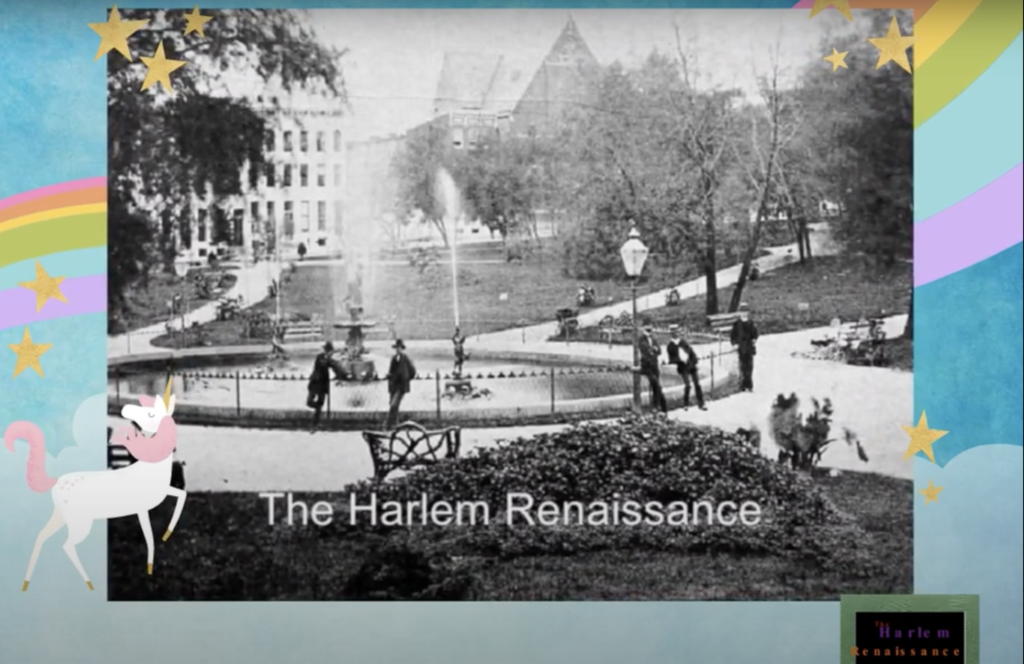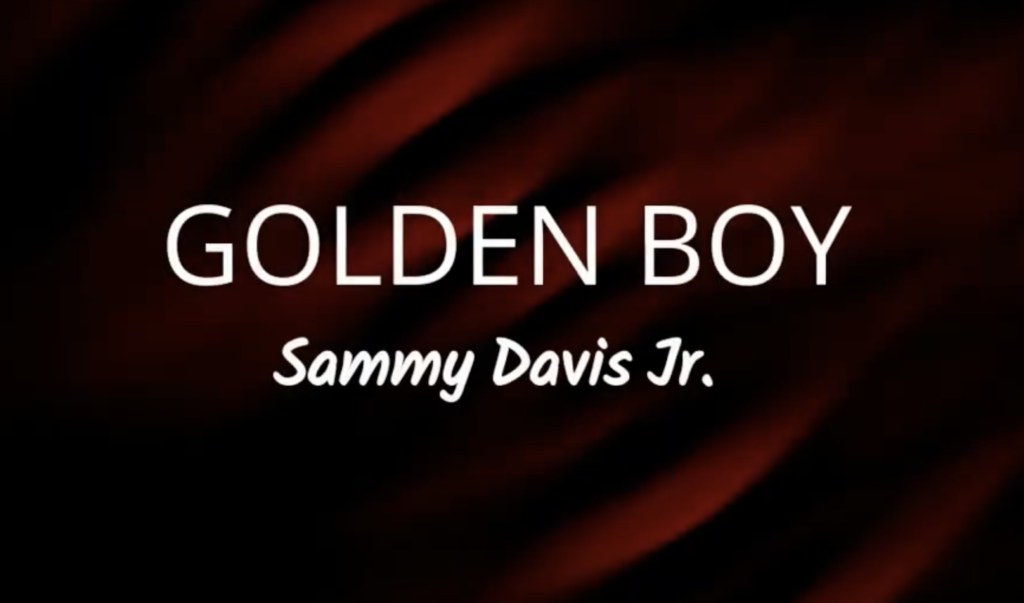Broadway and Film History Educational Video Archive
The HARLEM Renaissance

“The Harlem Renaissance (the New Negro Movement) refers to the flowering of African American cultural and intellectual life during the 1920s and 1930s. At the time, it was known as the “New Negro Movement”, named after the 1925 anthology ‘The New Negro’ – “The Harlem Renaissance was an American cultural movement of the 1920s and 1930s. Named after the Harlem community of New York City, this period brought about some of the most influential African-American visual artists, musicians, writers, and dancers. In later decades, the Harlem Renaissance influenced the American Civil Rights Movement.”
ARTIST
Aaron Douglas
Archibald Motley, Jr.
Jacob Lawrence
Romare Bearden
Augusta Savage
Harlem Renaissance ideas had spread to other cities in the United States.
MUSIC
Sony Music Entertainment
Rockin’ In Rhythm
It Don’t Mean a Thing (If It Ain’t Got That Swing
Take the “A” Train · Duke Ellington
“Piano In The Background”
℗ Originally recorded in 1960 & released in 2004. All rights reserved by Columbia Records, a division of Sony Music Entertainment
I DO NOT OWN THE RIGHTS TO THE PHOTOS AND MUSIC PRESENTED IN THIS EDUCATIONAL SLIDE PRESENTATION
EDUCATION / ENTERTAINMENT PURPOSES ONLY
Dale Ricardo Shields
Iforcolor.org (DRS)
*****
Golden Boy [Sammy Davis Jr.]

Dale Ricardo Shields
Educational Video/Slide Presentation
Golden Boy (Broadway)
[ http://sammydavisjr.info/stage/musica… ]
I do not own the rights to the music and photos presented in this educational slide /video.
PHOTOS
LEROY NEIMAN ORIGINAL (Boxing) The Golden Boy
Copyright 2014 NeimansOnly.com
(Photo by Leonard Mccombe /The LIFE Picture Collection via Getty Images)
talcollections.nypl.org
MUSIC:
Golden Boy
℗ 1964 Capitol Records, LLC
Released on: 1964-01-01
Composer: Charles Strouse
Author: Lee Adams
Opening Date: 20 October 1964 / Closing Date: 5 March 1966
Performances: 569 performances
Venue: Majestic Theatre, New York
Producer: Hillard Elkins / Director: Arthur Penn
Cast: Sammy Davis, Jr., Paula Wayne, Billy Daniels, Ted Beniades, Kenneth Tobey, Roy Glenn, Johnny Brown, Charles Welch, Jeannette DuBois, Louis Gossett, Jaime Rogers.
Book: William Gibson and Clifford Odets
Music and Lyrics: Charles Strouse and Lee Adams
Musical Director: Elliot Lawrence
Tryouts: Shubert Theatre, Philadelphia – 25 June to 25 July 1964
Shubert Theatre, Boston – 28 July to 22 August 1964
Fisher Theater, Detroit – 25 August to 29 September 1964
Details
“A project which would play a significant role in the life of Sammy Davis, Jr. for seven years was born when producer Hillard Elkins saw Sammy performing at a ‘midnight matinee’ in London at the Prince of Wales Theatre in September 1961. In Sammy’s dressing room after the show, Elkins implored him to return to Broadway (Sammy had starred in Mr. Wonderful in 1956). Elkins suggested he had the right vehicle: Golden Boy, the tremendously successful 1937 stage play written by Clifford Odets. The play was about an Italian-American concert violinist, Joe Bonaparte, who turned to boxing. It had subsequently been made into a film starring William Holden, in his film debut. Featuring a tragic death in the ring, it was a serious work exploring the immigrant experience and the machinations of the boxing world. Sammy was interested.
Elkins began a two-year process of bringing his idea to fruition. He met with Odets and obtained not only his permission to adapt the play, but also Odet’s agreement to write the book for the musical adaption himself. Elkins and Sammy envisioned a racial equality angle to replace the immigrant/class themes in the original. Elkins secured the services of composer Charles Strouse and lyricist Lee Adams (who had impressed with their score for Bye, Bye Birdie) to write the music. Although Sammy had not officially signed on, the two writers followed Sammy around the country testing jingles, songs, and ideas, to see what would work for him.
Civil Rights Impact
Having a fully integrated company, and running at the height of the civil rights era, Golden Boy had significant cultural resonance. It was the first time in a long time that a Broadway audience had been confronted with real social and political frustration. Its big production number, “Don’t Forget 127th Street” was sarcastic, cynical, and mocked the Broadway trope of poor people being content with their lot, and loving the slum where they live.
While the critics might have been happy, not everyone was pleased to see an interracial romance on stage in New York in 1964. The Act II kiss between Lorna and Joe scandalized audiences during tryouts, and the show received numerous bomb and death threats right from its opening days in Philadelphia until its close on Broadway in March 1966. All the principal people in the production received bodyguard protection.
Paula Wayne recalled: “I never expected such hatred. I never expected such vitriolic things would be said to me. But Sammy did. He told me the only way to deal with hatred is not to dignify it. And he always stood by me.”
In late March 1965, Sammy was given time off the show to participate in the Selma to Montgomery March, alongside Martin Luther King, Jr. The civil rights leader had already been to watch Golden Boy, and King is said to have been particularly drawn to the big gospel number “No More” (“I ain’t bowin’ down, No more!”). Sammy continued his work fundraising for civil rights causes during Golden Boy’s run, and in April, Hilly Elkins and Sammy produced and hosted a benefit show for King’s Southern Christian Leadership Conference called Broadway Answers Selma.
Tony Award Nomination
In late May 1965, Tony Award Nominations were announced. Golden Boy appeared in four categories, Best Musical, Best Producer (Musical) – Hillard Elkins, Best Choreography – Donald McKayle, and Best Performance by a Leading Actor in a Musical – Sammy Davis, Jr. The Awards ceremony was held at The Astor Hotel on 13th June, but Golden Boy lost in all four categories to the respective nominations from Fiddler on the Roof.”
EDUCATIONAL PURPOSE ONLY
NO COPYRIGHT INFRINGEMENT INTENDED
*****
EUBIE! 43rd BROADWAY Celebration

Eubie! Is a revue featuring the music of jazz/swing composer Eubie Blake, with lyrics by Noble Sissle, Andy Razaf, Johnny Brandon, F. E. Miller, and Jim Europe. The show showcases 23 of Eubie Blake’s best songs. The idea of the show was conceived by Julianne Boyd. It opened on September 20, 1978, at the Ambassador Theatre, where it ran for 439 performances. Produced by Ashton Springer. The show was conceived and directed by Julianne Boyd, choreographed by Billy Wilson and Henry LeTang, set design by Karl Eigsti, and costumed by Bernard Johnston. Choral arrangements by Chapman Roberts. Vicki Carter was the musical director, pianist, and conductor. Lou Gonzalez was the sound designer. Eubie Blake was nearly 100 years of age when the show opened. Many of the songs were from the Blake-Sissle 1921 show Shuffle Along. An original cast recording was produced by Warner Brothers and released on vinyl in 1979 and was later released on CD. – Wikipedia
The original cast of Eubie! included an all-Black cast consisting of 12 performers and nine musicians. The performers were Ethel Beatty, Terry Burrell, Leslie Dockery, Lynnie Godfrey, Gregory Hines, Maurice Hines, Mel Johnson Jr., Lonnie McNeil, Janet Powell, Marion Ramsey, Alaina Reed, and Jeffery V. Thompson. Production Stage Manager – Clinton Turner Davis
I DO NOT OWN THE MUSIC AND THE PHOTOGRAPHS PRESENTED IN THE ENTERTAINMENT SLIDE/VIDEO PRESENTATION.
MUSIC:
Baltimore Todolo
Martin Spitznagel – Official
Provided to YouTube by The Orchard Enterprises
Baltimore Todolo · Martin Spitznagel · Brian Holland · Danny Coots
Three’s Company
℗ 2014 Rivermont Records
Released on: 2014-04-15
Auto-generated by YouTube.
NO COPYRIGHT INFRINGEMENT INTENDED. ENTERTAINMENT ONLY.
*****
THE WIZ – MEMORY DOWN THE ROAD

THE WIZ – MEMORY DOWN THE ROAD
IFORCOLOR Collective
Dale Ricardo Shields
Iforcolor.org
PHOTOS BY Martha Swope / NYPL
The Wiz
The Super Soul Musical “Wonderful Wizard of Oz”
The Wiz: The Super Soul Musical “Wonderful Wizard of Oz” is a musical with music and lyrics by Charlie Smalls (and others) and a book by William F. Brown. It is a retelling of L. Frank Baum’s children’s novel The Wonderful Wizard of Oz (1900) is in the context of contemporary African-American culture. It opened on October 21, 1974, at the Morris A. Mechanic Theatre in Baltimore, and moved to Broadway’s Majestic Theatre with a new cast on January 5, 1975.
The 1975 Broadway production won seven Tony Awards, including Best Musical. It was an early example of Broadway’s mainstream acceptance of works with an all-Black cast. It has had revivals in New York, London, San Diego, and the Netherlands, and a limited-run revival was presented by Encores! at New York City Center in June 2009. A big-budget film adaptation of the same name was released in 1978, with Ted Ross and Mabel King reprising their roles. A live television production of the stage version, The Wiz Live!, was broadcast on NBC on December 3, 2015, with an encore presentation on December 19 of the same year.
Music Charlie Smalls
Timothy Graphenreed
Harold Wheeler
George Faison
Luther Vandross
Lyrics Charlie Smalls
Zachary Walzer
Luther Vandross
Book William F. Brown
Basis The Wonderful Wizard of Oz
by L. Frank Baum
NO COPYRIGHT INFRINGEMENT INTENDED – I DO NOT OWN THE RIGHTS TO THE PHOTOGRAPHS AND MUSIC IN THIS EDUCATIONAL SLIDE/VIDEO.
*****
DREAMGIRLS 40th Anniversary

Dreamgirls is a Broadway musical, with music by Henry Krieger and lyrics and book by Tom Eyen. Based on the show business aspirations and successes of R&B acts such as The Supremes, The Shirelles, James Brown, Jackie Wilson, and others, the musical follows the story of a young female singing trio from Chicago, Illinois called “The Dreams”, who become music superstars.
SLIDE/VIDEO by DALE RICARDO SHIELDS
{ Photographs by MARTHA SWOPE } – GETTY IMAGES – PLAYBILL – BROADWAY WORLD
[ I DO NOT OWN THE RIGHTS TO THE PHOTOGRAPHS/VISUALS and MUSIC PRESENTED IN THIS ENTERTAINMENT/EDUCATIONAL SLIDE/VIDEO ]
* No copyright infringement intended*
Staged with a mostly African-American cast and originally starring Jennifer Holliday, Sheryl Lee Ralph, Loretta Devine, Ben Harney, Cleavant Derricks, Vondie Curtis-Hall, and Obba Babatundé, the musical opened on December 20, 1981, at the Imperial Theatre on Broadway. The musical was then nominated for 13 Tony Awards, including the Tony Award for Best Musical, and won six. (Wikipedia)
Dreamgirls – Produced by Michael Bennett, Bob Avian, Geffen Records, and The Shubert Organization (Gerald Schoenfeld: Chairman; Bernard B. Jacobs: President)
Music by Henry Krieger
Book by Tom Eyen
Lyrics by Tom Eyen
Music orchestrated by Harold Wheeler
Musical Director: Yolanda Segovia
Vocal arrangements by Cleavant Derricks
Directed by Michael Bennett
Choreographed by Michael Bennett and Michael Peters
Scenic Design by Robin Wagner
Lighting Design by Tharon Musser
Costume Design by Theoni V. Aldredge
Production Stage Manager – Jeffrey Hamlin
Jennifer Holliday, Effie Melody White.
Sheryl Lee Ralph: Deena Jones.
Ben Harney, Curtis Taylor Jr.
Obba Babatundé, C.C. White.
Loretta Devine, Lorrell Robinson.
Cleavant Derricks, James “Thunder” Early.
Deborah Burrell, Michelle Morris.
Vondie Curtis-Hall, Marty
Joe Lynn, Tiny Joe Dixon, Jerry
Tony Franklin, Wayne
David Thomé, Frank
MUSIC
“DREAMGIRLS“
“HARD TO SAY GOODBYE“
Provided to YouTube by Universal Music Group
Dreamgirls: Original Broadway Cast Album
℗ 1982 Universal Classics Group, a Division of UMG Recordings Inc.
Released on: 2006-01-01
Producer: David Foster
Author: Tom Eyen
Composer: Henry Krieger
OPENING – DECEMBER 20, 1981 * CLOSING – August 11, 1985
1, 521 performances
https://en.wikipedia.org/wiki/Dreamgirls
https://www.playbill.com/production/d…
YOUTUBE CHANNEL – https://www.youtube.com/@Moderndrama/videos
HISTORICAL Video’s
WE’VE COME THIS FAR BY FAITH – BLACK HISTORY MONTH – 2022 Iforcolor (Collective)
THE LITTLE ROCK NINE – (IFORCOLOR Collective)
A PROTEST AGAINST RACISM {GEORGE FLOYD}
Uvalde Massacre 2022
PEOPLE
MARY WILSON – A Supreme Tribute {1944 – 2021}
FLORENCE BALLARD***** – Heaven’s Supreme Angel
NO COPYRIGHT INFRINGEMENT INTENDED – Educational Purposes Only – DRS
SONDHEIM: A Magical Musical Life
